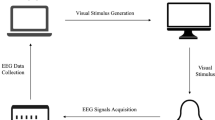Abstract
This study examined effects of uncorrected refractive errors (RE) in a short-duration transient visual evoked potential (SD t-VEP) system and investigated their role for objective measurement of RE. Refractive errors were induced by means of trial lenses in 35 emmetropic subjects. A synchronized single-channel EEG was recorded for emmetropia, and each simulated refractive state to generate 21 VEP responses for each subject. P100 amplitude (N75 trough to P100 peak) and latency were identified by an automated post-signal processing algorithm. Induced hypermetropia and myopia correlated strongly with both P100 amplitude and latency. To minimize the effect of baseline shift and waveform fluctuations, a VEP scoring system, based on software-derived P100 latency, amplitude and waveform quality, was used to estimate the RE. Using the VEP scores, a single VEP response had a high sensitivity and specificity for discerning emmetropia, small RE (<2 diopter) within a 2 diopter range and large RE (2–14 diopter) within a 4 diopter range. The VEP scoring system has a potential for objective screening of RE and for a more accurate 3-step objective refraction.



Similar content being viewed by others
References
Armington JC (1968) The electroretinogram, the visual evoked potential, and the area-luminance relation. Vis Res 8:263–276
Spehlmann R (1965) The averaged electrical responses to diffuse and to patterned light in the human. Electroencephalogr Clin Neurophysiol 19:560–569
Harter MR, White CT (1968) Effects of contour sharpness and check-size on visually evoked cortical potentials. Vis Res 8:701–711
Millodot M, Riggs LA (1970) Refraction determined electrophysiologically. Responses to alternation of visual contours. Arch Ophthalmol 84:272–278
Sokol S, Moskowitz A (1981) Effect of retinal blur on the peak latency of the pattern evoked potential. Vis Res 21:1279–1286
Collins DW, Carroll WM, Black JL, Walsh M (1979) Effect of refractive error on the visual evoked response. Br Med J 1:231–232
Rietveld WJ, Tordoir WE, Hagenouw JR, Lubbers JA, Spoor TA (1967) Visual evoked responses to blank and to checkerboard patterned flashes. Acta Physiol Pharmacol Neerl 14:259–285
Mezer E, Bahir Y, Leibu R, Perlman I (2004) Effect of defocusing and of distracted attention upon recordings of the visual evoked potential. Doc Ophthalmol 109:229–238
Regan D (1973) Rapid objective refraction using evoked brain potentials. Invest Ophthalmol 12:669–679
Bostrom C, Keller EL, Marg E (1978) A reconsideration of visual evoked potentials for fast automated ophthalmic refractions. Invest Ophthalmol Vis Sci 17:182–185
Tello C, De Moraes CG, Prata TS, Derr P, Patel J, Siegfried J, Liebmann JM, Ritch R (2010) Repeatability of short-duration transient visual evoked potentials in normal subjects. Doc Ophthalmol 120:219–228
Regan D, Richards W (1973) Brightness contrast and evoked potentials. J Opt Soc Am 63:606–611
May JG, Cullen JK Jr, Moskowitz-Cook A, Siegfried JB (1979) Effects of meridional variation on steady-state visual evoked potentials. Vis Res 19:1395–1401
Shaw NA, Cant BR (1981) Age-dependent changes in the amplitude of the pattern visual evoked potential. Electroencephalogr Clin Neurophysiol 51:671–673
Tobimatsu S, Kurita-Tashima S, Nakayama-Hiromatsu M, Akazawa K, Kato M (1993) Age-related changes in pattern visual evoked potentials: differential effects of luminance, contrast and check size. Electroencephalogr Clin Neurophysiol 88:12–19
Glickstein M, Millodot M (1970) Retinoscopy and eye size. Science 168:605–606
Conflict of interests
Aashish Anand: None; Carlos Gustavo V De Moraes: None; Christopher C Teng: None; Jeffrey M Liebmann: Served as a consultant for Diopsys, Inc., Allergan, Inc., Alcon Laboratories, Inc., Optovue, Inc., Quark Pharmaceuticals, Inc., Topcon Medical Systems, Inc., Grant support from Carl Zeiss Meditec, Diopsys, Inc., Heidelberg Engineering, Optovue, Inc., Topcon Medical Systems; Robert Ritch: Invited lectures for Alcon Laboratories, Inc., Allergan, Inc., Merck, Inc., Pfizer, Inc.; Celso Tello: Served as a consultant for Diopsys, Inc., SOLX, Inc., Invited lectures for Alcon Laboratories, Inc., Allergan, Inc.
Author information
Authors and Affiliations
Corresponding author
Rights and permissions
About this article
Cite this article
Anand, A., De Moraes, C.G.V., Teng, C.C. et al. Short-duration transient visual evoked potential for objective measurement of refractive errors. Doc Ophthalmol 123, 141–147 (2011). https://doi.org/10.1007/s10633-011-9289-7
Received:
Accepted:
Published:
Issue Date:
DOI: https://doi.org/10.1007/s10633-011-9289-7




